Intel recently launched their 11th gen Tiger Lake processors which come paired with their new Xe graphics. I want to find out how this stacks up against the Radeon Vega graphics in the Ryzen 4000 U series processors, so I’ve compared the two in 10 games in this review to show you the differences.
CPU spec differences
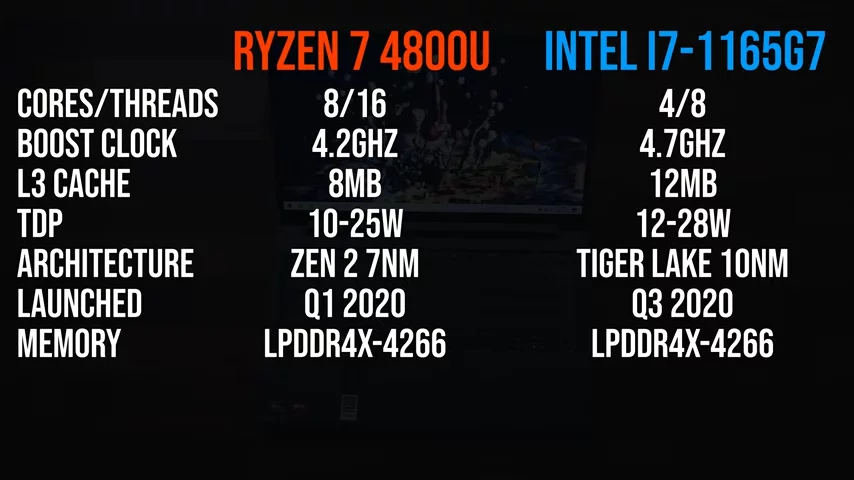 There are some fairly big differences between these two chips outside of the GPU component. The 4800U is an 8 core 16 thread part, while the 1165G7 is a 4 core 8 thread part.
There are some fairly big differences between these two chips outside of the GPU component. The 4800U is an 8 core 16 thread part, while the 1165G7 is a 4 core 8 thread part. 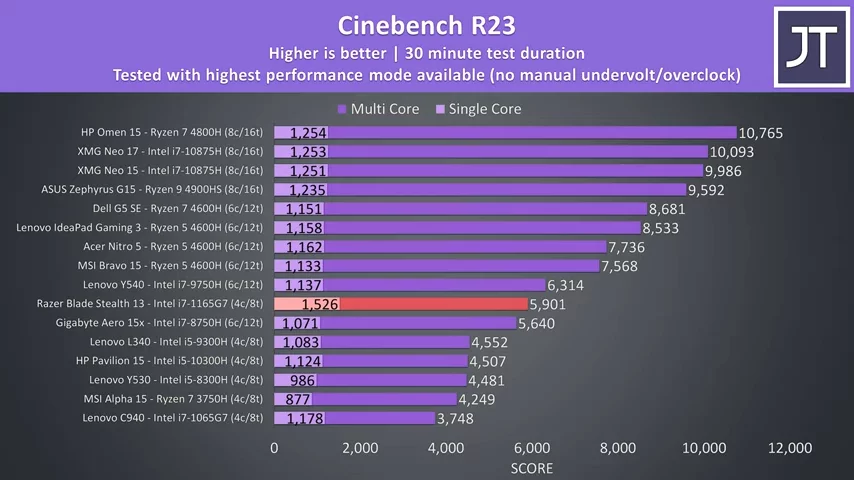 Despite this, the Tiger Lake chip can beat some older 6 core Intel designs like the 8750H in multicore performance, and the single core performance is on another level compared to higher end H series Ryzen chips. Basically I’ve used these two to compare as they’re higher end options from the lower powered U series, so we should be looking at close to best results from both Intel and AMD.
Despite this, the Tiger Lake chip can beat some older 6 core Intel designs like the 8750H in multicore performance, and the single core performance is on another level compared to higher end H series Ryzen chips. Basically I’ve used these two to compare as they’re higher end options from the lower powered U series, so we should be looking at close to best results from both Intel and AMD.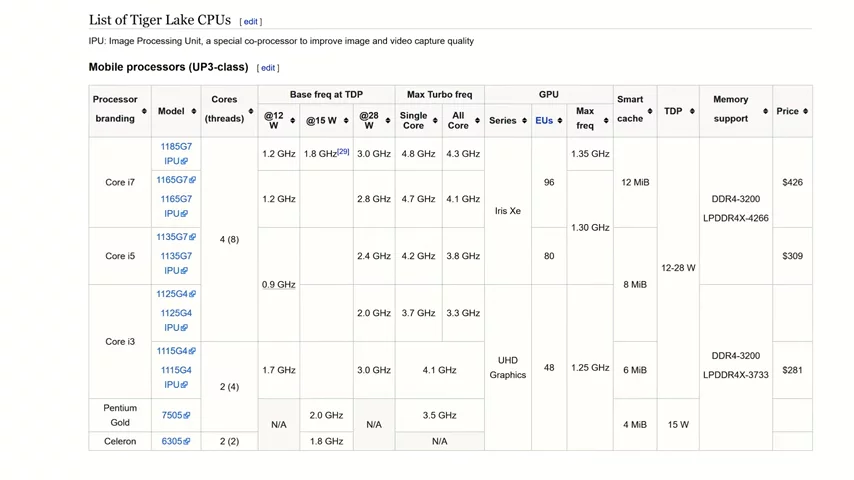 It would have made more sense to instead compare using Intel’s i7-1185G7, as that’s the highest specced option from the Tiger Lake lineup, but I wasn’t able to get that one, and as we can see here in the specs, the Xe graphics are only 50MHz faster with that one anyway, so results likely wouldn’t be all that different.
It would have made more sense to instead compare using Intel’s i7-1185G7, as that’s the highest specced option from the Tiger Lake lineup, but I wasn’t able to get that one, and as we can see here in the specs, the Xe graphics are only 50MHz faster with that one anyway, so results likely wouldn’t be all that different.
Laptops tested
For the AMD Ryzen 7 4800U I’ve used the Lenovo Slim 7, and for the Intel i7-1165G7 I’ve used the Razer Blade Stealth 13. Now the Blade Stealth does also have Nvidia GTX 1650 Ti Max-Q graphics, but I’ve disabled that in device manager so that only Intel Xe graphics was available for all testing. I’ve tested most of the 10 games at 720p, but I’ve also done a few at 1080p where it made sense, so let’s get into the results.
Game benchmarks
Shadow of the Tomb Raider was tested with the games benchmark. 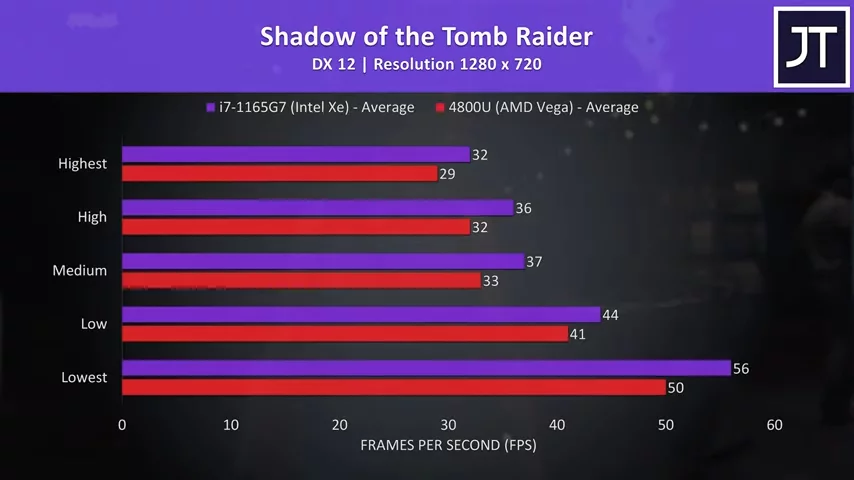 I’ve got the Intel Xe graphics shown by the purple bars, and AMD Radeon Vega shown in red. Regardless of setting level, this was a win for the Intel graphics, which was reaching 10% higher average FPS at max settings, granted this was just 3 frames.
I’ve got the Intel Xe graphics shown by the purple bars, and AMD Radeon Vega shown in red. Regardless of setting level, this was a win for the Intel graphics, which was reaching 10% higher average FPS at max settings, granted this was just 3 frames. 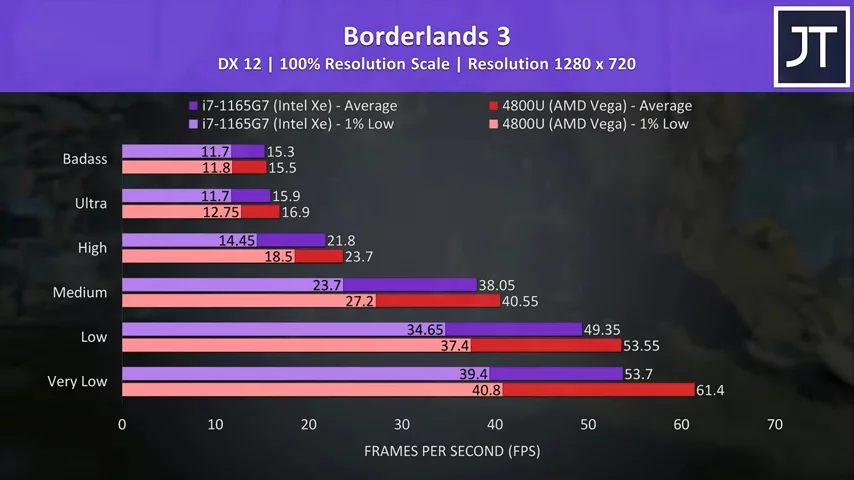 Borderlands 3 was tested with the games benchmark tool, and this one was a win for AMD regardless of setting level in use. There’s a much smaller difference between them at the higher setting presets, AMD has a larger lead at the lower levels, for instance at max Vega is just 1% ahead, so basically nothing compared to its 14% lead at very low settings.
Borderlands 3 was tested with the games benchmark tool, and this one was a win for AMD regardless of setting level in use. There’s a much smaller difference between them at the higher setting presets, AMD has a larger lead at the lower levels, for instance at max Vega is just 1% ahead, so basically nothing compared to its 14% lead at very low settings. 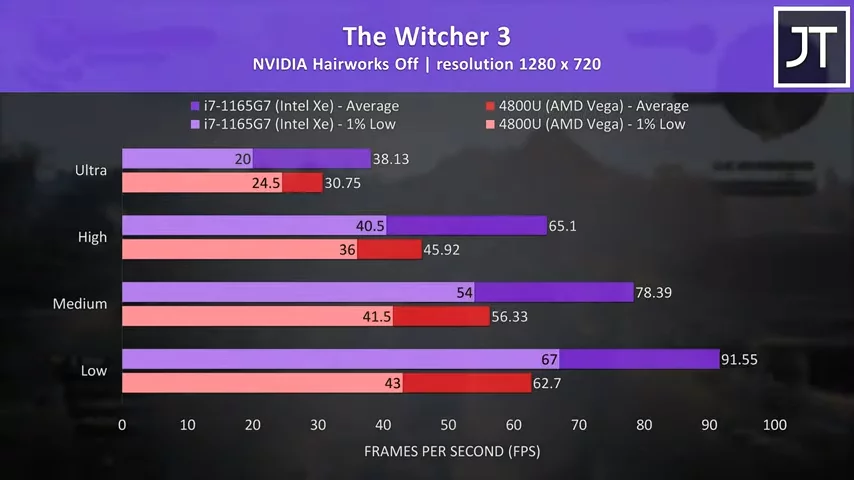 The Witcher 3 saw a similar pattern, but in the opposite direction. The Intel graphics were reaching 46% higher average FPS with the low setting preset, even the 1% low was above the average FPS from Vega, but at max settings Intel was 24% ahead, and AMD actually had a higher 1% low now.
The Witcher 3 saw a similar pattern, but in the opposite direction. The Intel graphics were reaching 46% higher average FPS with the low setting preset, even the 1% low was above the average FPS from Vega, but at max settings Intel was 24% ahead, and AMD actually had a higher 1% low now. 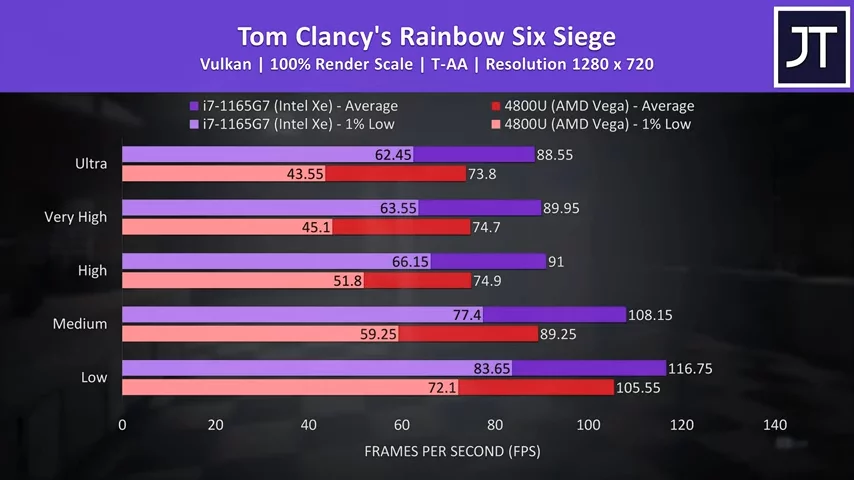 Rainbow Six Siege was tested with Vulkan, and this one was a win for the Intel system at all setting levels. At max settings, the Xe graphics were reaching 20% higher average FPS than the Vega graphics, but that said, both are still reaching playable frame rates even with fair settings here.
Rainbow Six Siege was tested with Vulkan, and this one was a win for the Intel system at all setting levels. At max settings, the Xe graphics were reaching 20% higher average FPS than the Vega graphics, but that said, both are still reaching playable frame rates even with fair settings here.
Let’s check out some esports titles next, starting with Dota 2, which was tested in the middle lane with bots.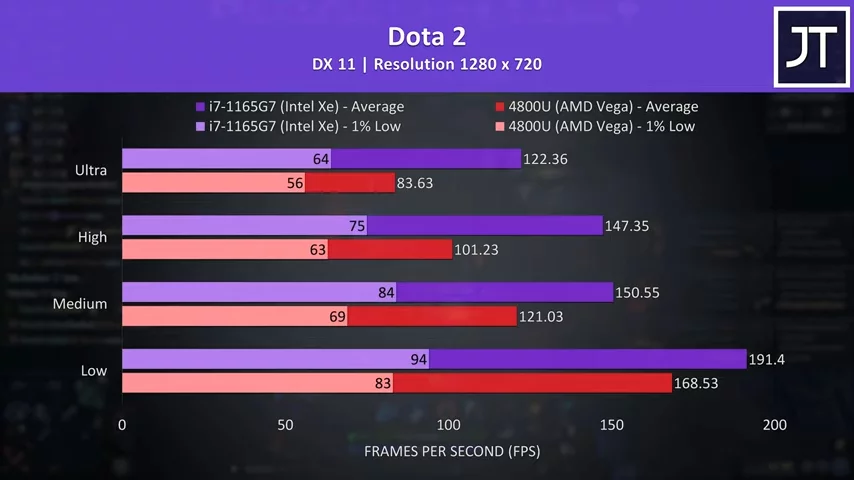 This is another win for Intel, which was reaching 46% higher average FPS at max settings, though the gap in 1% low was smaller comparatively at 14%.
This is another win for Intel, which was reaching 46% higher average FPS at max settings, though the gap in 1% low was smaller comparatively at 14%. 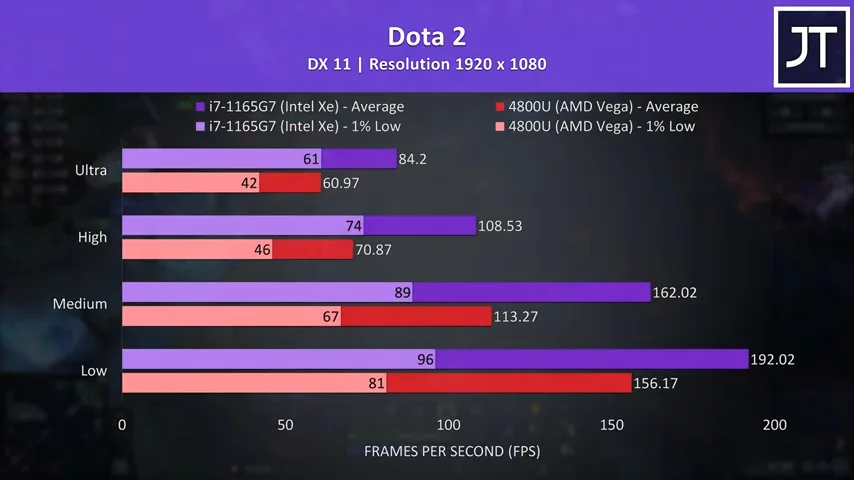 As we’re reaching such high frame rates in this one, I’ve also tested it out at 1080p. Despite Intel still winning, the Vega graphics are still delivering a 60 FPS average at ultra settings, a nice result, but regardless Intel Xe was still 38% ahead.
As we’re reaching such high frame rates in this one, I’ve also tested it out at 1080p. Despite Intel still winning, the Vega graphics are still delivering a 60 FPS average at ultra settings, a nice result, but regardless Intel Xe was still 38% ahead. 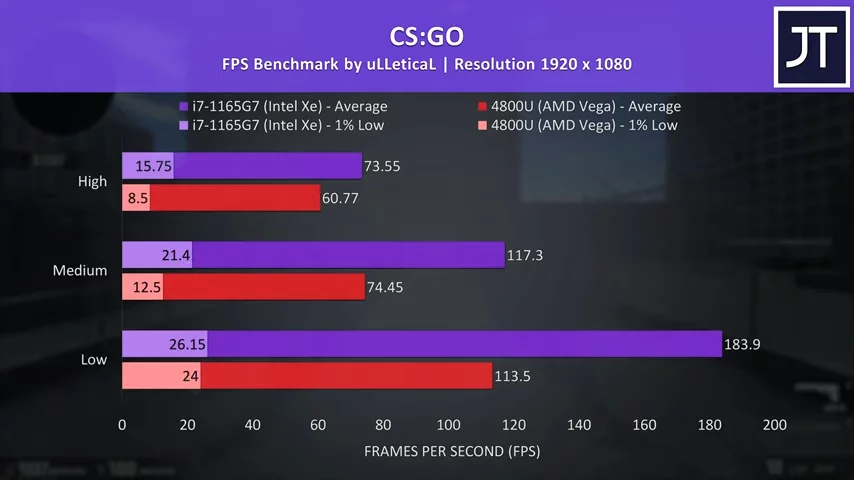 For some reason I forgot to test CS:GO at 720p when I had both machines, so I’ve only got 1080p results with this one. Again the Vega graphics were right on 60 FPS even with all settings at maximum, but the Xe graphics were reaching 21% higher average FPS here. The gap is even larger at lower settings, where Intel has a 62% lead, but this is likely due to lower settings depending less on the difference in GPU and more on the processor performance, and as we saw earlier Tiger Lake does offer nice single core performance.
For some reason I forgot to test CS:GO at 720p when I had both machines, so I’ve only got 1080p results with this one. Again the Vega graphics were right on 60 FPS even with all settings at maximum, but the Xe graphics were reaching 21% higher average FPS here. The gap is even larger at lower settings, where Intel has a 62% lead, but this is likely due to lower settings depending less on the difference in GPU and more on the processor performance, and as we saw earlier Tiger Lake does offer nice single core performance.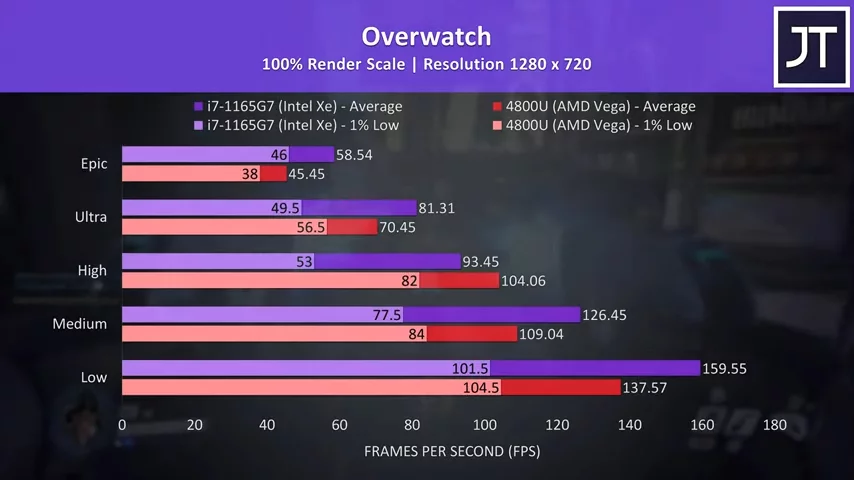 Overwatch was tested in the practice range. The results here were a bit different to most others, Intel was ahead at all setting levels but high settings, where for some reason AMD happened to have the lead, particularly in 1% low, but for the most part at most of the settings Intel was doing better, with a 29% higher average FPS at the highest epic settings.
Overwatch was tested in the practice range. The results here were a bit different to most others, Intel was ahead at all setting levels but high settings, where for some reason AMD happened to have the lead, particularly in 1% low, but for the most part at most of the settings Intel was doing better, with a 29% higher average FPS at the highest epic settings.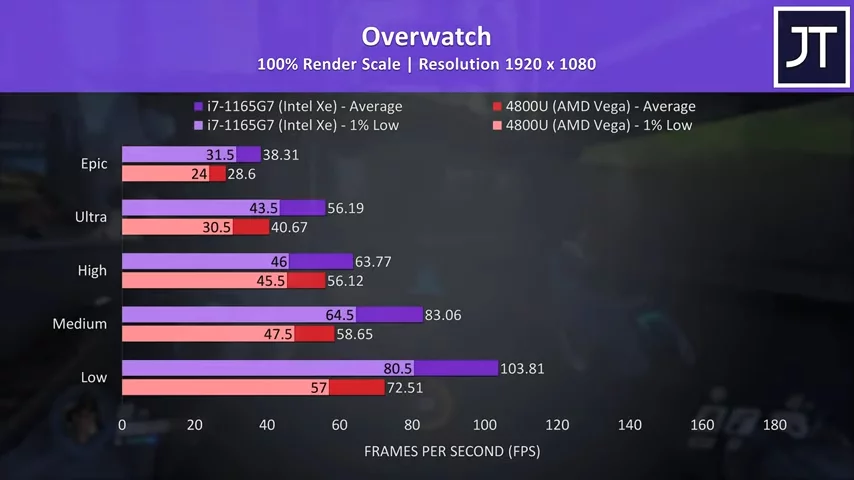 This was another that I’ve also tested at the higher 1080p resolution. At max settings now the Xe graphics was further ahead with a 34% lead over Vega. The Xe graphics are able to get us above 60 FPS with the high setting preset, while the Vega graphics couldn’t quite get there with medium settings.
This was another that I’ve also tested at the higher 1080p resolution. At max settings now the Xe graphics was further ahead with a 34% lead over Vega. The Xe graphics are able to get us above 60 FPS with the high setting preset, while the Vega graphics couldn’t quite get there with medium settings. 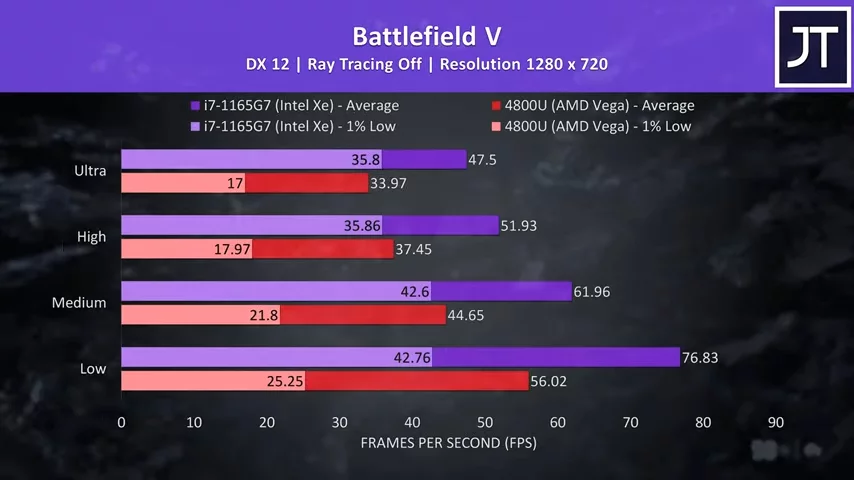 Battlefield 5 was doing significantly better on the Xe graphics, coming out 40% ahead of the Radeon graphics in average frame rate at the highest ultra setting preset, though there was a larger 111% improvement in the 1% low.
Battlefield 5 was doing significantly better on the Xe graphics, coming out 40% ahead of the Radeon graphics in average frame rate at the highest ultra setting preset, though there was a larger 111% improvement in the 1% low.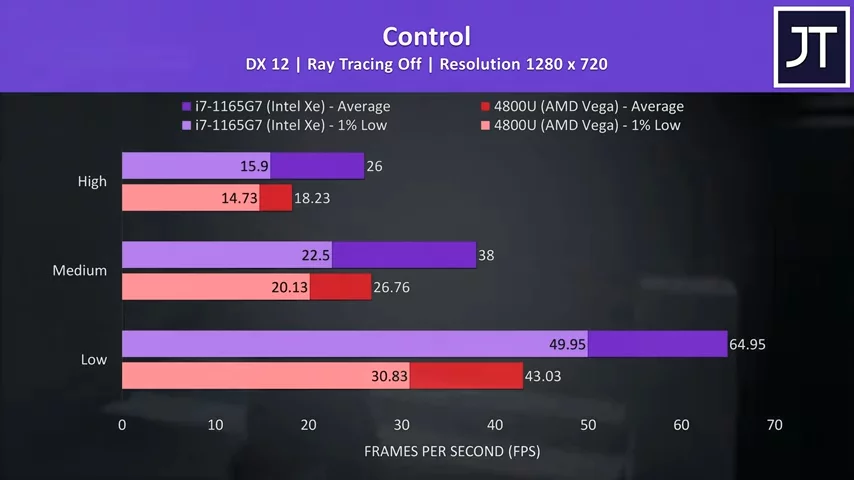 Control was also ahead on the Intel Xe graphics, again more than a 40% improvement to average frame rate at max settings, granted even at 720p I don’t think I’d want to play at 26 FPS. Low settings on the other hand was still usable on the Vega graphics, however Intel Xe was able to reach above 60 FPS, putting it 51% ahead here.
Control was also ahead on the Intel Xe graphics, again more than a 40% improvement to average frame rate at max settings, granted even at 720p I don’t think I’d want to play at 26 FPS. Low settings on the other hand was still usable on the Vega graphics, however Intel Xe was able to reach above 60 FPS, putting it 51% ahead here. 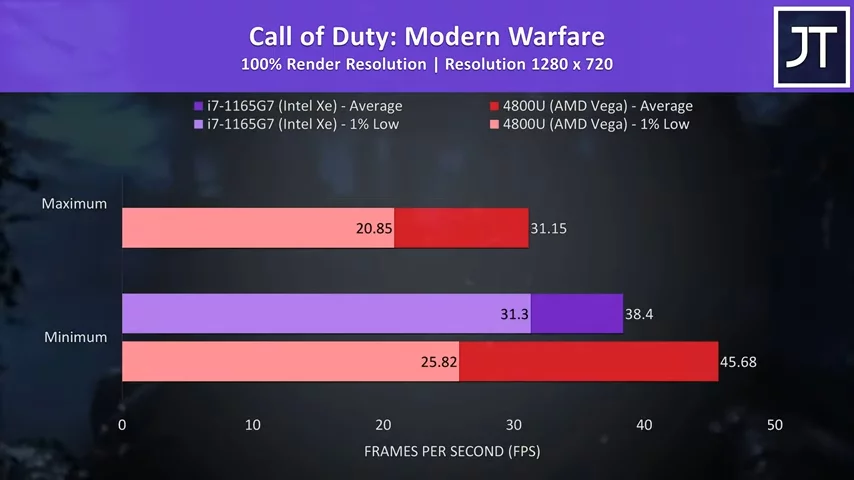 Call of Duty Modern Warfare was doing better on AMD, maybe. It’s hard to tell, because it kept crashing at max settings even after multiple reboots and reinstalls, it just didn’t seem to like Xe graphics I guess, more on that later.
Call of Duty Modern Warfare was doing better on AMD, maybe. It’s hard to tell, because it kept crashing at max settings even after multiple reboots and reinstalls, it just didn’t seem to like Xe graphics I guess, more on that later.
Differences in all games
That said, despite average FPS at minimum settings being ahead on Vega, the 1% low from Xe was still better.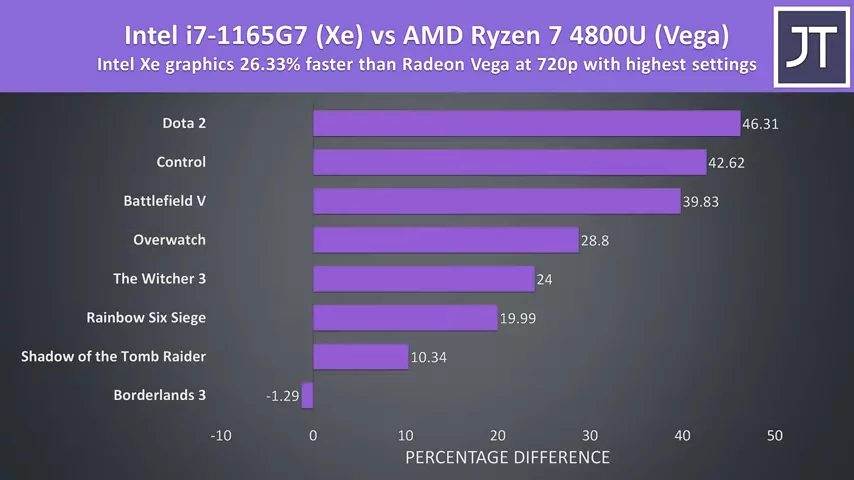 These are the average differences out of all games tested. I’m only looking at max settings here, as these tend to be most GPU heavy, and this is a GPU comparison after all. It’s a clear win for Intel, AMD was only ahead in borderlands 3 in terms of average frame rate, that may have also been case in Call of Duty but Intel crashed preventing proper comparison. For the most part the Intel gains were fairly significant.
These are the average differences out of all games tested. I’m only looking at max settings here, as these tend to be most GPU heavy, and this is a GPU comparison after all. It’s a clear win for Intel, AMD was only ahead in borderlands 3 in terms of average frame rate, that may have also been case in Call of Duty but Intel crashed preventing proper comparison. For the most part the Intel gains were fairly significant. 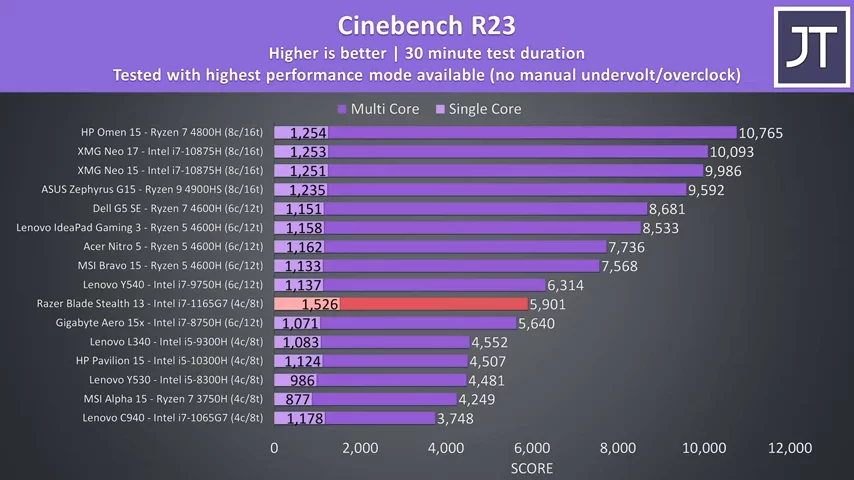 It’s difficult to say how much of this difference is purely down to the GPU, as Tiger Lake was also doing better in raw processing performance, at least in single core, I doubt many games will see a benefit from the 8 cores of Ryzen.
It’s difficult to say how much of this difference is purely down to the GPU, as Tiger Lake was also doing better in raw processing performance, at least in single core, I doubt many games will see a benefit from the 8 cores of Ryzen.
Regardless at the end of the day it’s a win for Intel, and don’t forget I’m not even using the higher tier i7-1185G7. 1080p might have been better for a GPU comparison, but as we’ve seen in many of the AAA games 720p was often a struggle at higher settings, so I stuck to an actual playable resolution.
Intel Xe stability issues
It’s also worth talking about some stability issues I had. Overall, the AMD Vega graphics offered a more stable gaming experience, it seems that Intel Xe drivers still have some improvements to be made. For instance, while playing Control with Xe graphics all the lighting was bright red making it difficult to play. I had artifacting when running Rainbow Six Siege, and there were plenty of crashes in COD and Shadow of the Tomb Raider. I suppose it could just be my laptop, but to me it seems that Xe graphics just need some more time to offer a stable experience, despite performing better.
Ultrabook gaming discussion
This comparison is mostly going to be useful for smaller ultrabook style machines with these processors that don’t have discrete Nvidia graphics inside for gaming. Integrated graphics have evolved a fair bit recently, and as we’ve seen 720p gaming even with modern titles on either goes quite well, even with decent setting levels in many cases, and while both offer fair levels of performance, the newer Intel Xe graphics did have the lead. This is going to be great for people that want to play games on the go without investing in thicker gaming laptops.
You could definitely argue that the Blade Stealth I’m using has been designed for gaming and may have better cooling, but fact is the processor still runs at Intel’s spec of 28 watts, so I don’t think that will change the conclusion too much unless you’re looking at more of an ultraportable style machine with a 15 watt power limit.
Ryzen 5000 soon?
We also can’t forget about AMD’s Ryzen 5000. Things might change once Ryzen 5000 series processors launch in early 2021, we’ll have to wait and see. If they move from using Vega to Navi it could offer a nice graphical boost, of course alongside all the other improvements on offer from Zen 3.
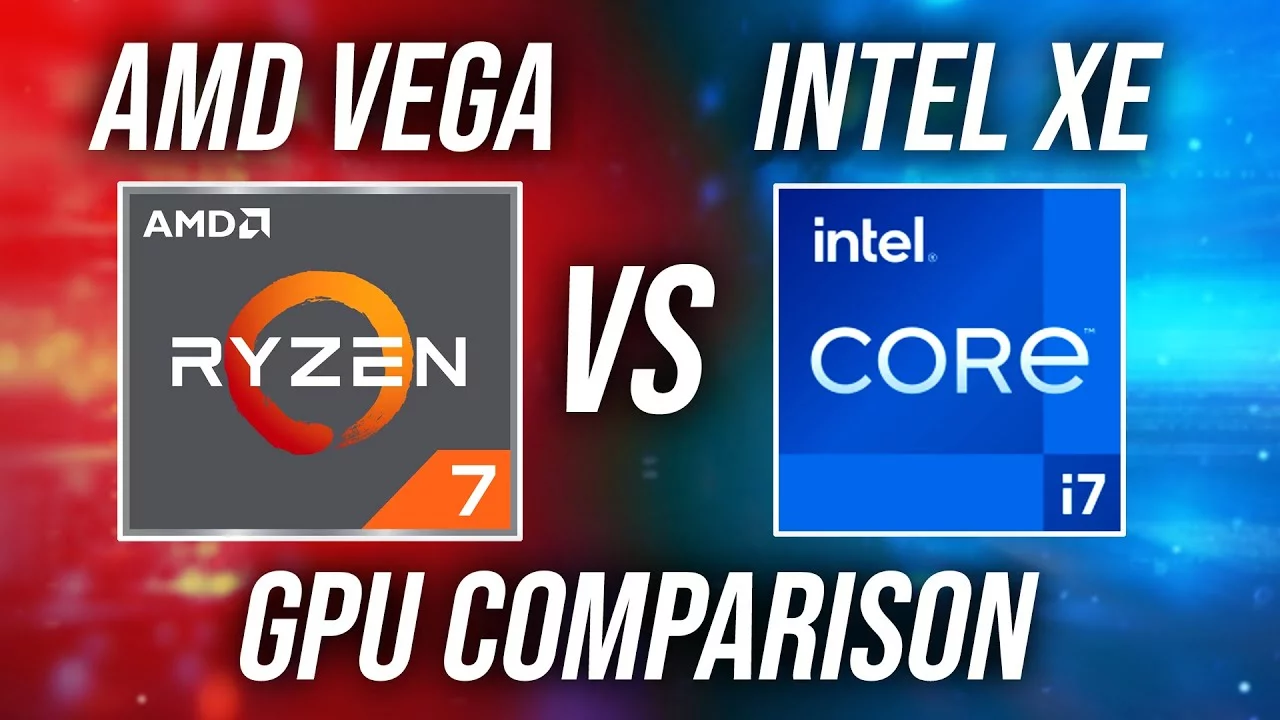

No comments yet